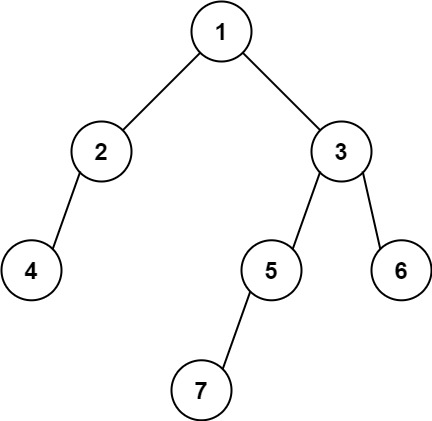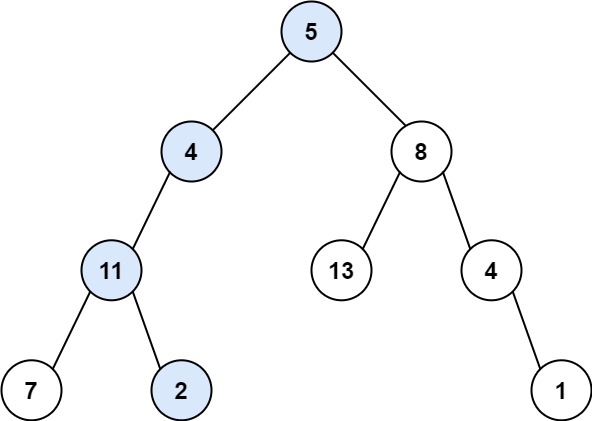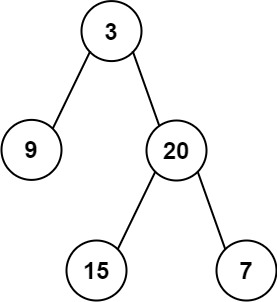代码随想录算法 - 二叉树3
题目1513. 找树左下角的值
给定一个二叉树的 根节点 root,请找出该二叉树的 最底层 最左边 节点的值。
假设二叉树中至少有一个节点。
示例 1:

输入: root = [2,1,3]
输出: 1
示例 2:

输入: [1,2,3,4,null,5,6,null,null,7]
输出: 7
提示:
- 二叉树的节点个数的范围是
[1,104] -231 <= Node.val <= 231 - 1
思路
迭代法
用辅助queue进行层序遍历就行了,直到最后一层遍历完,取出最左边的节点。
代码
class Solution {
public:
int findBottomLeftValue(TreeNode* root) {
if(!root->left && !root->right)
{
return root->val;
}
queue<TreeNode*> nodeQueue;
TreeNode* result;
nodeQueue.push(root);
while(!nodeQueue.empty())
{
int num = nodeQueue.size();
if(num > 0)
{
result = nodeQueue.front();
}
for(int i = 0; i < num; i++)
{
TreeNode* curNode = nodeQueue.front();
nodeQueue.pop();
if(curNode->left)
{
nodeQueue.push(curNode->left);
}
if(curNode->right)
{
nodeQueue.push(curNode->right);
}
}
}
return result->val;
}
};
递归法
用辅助变量maxdepth和depth来判断叶子节点是否是左下角的节点,其他的部分就先序遍历做就行了。
代码
class Solution {
public:
int result;
int maxDepth;
void getResult(TreeNode* root, int depth)
{
//碰到叶子节点判断是否为最深的左叶子
if(!root->left && !root->right)
{
if(depth > maxDepth)
{
maxDepth = depth;
result = root->val;
}
return;
}
if(root->left)
{
getResult(root->left, depth + 1);
}
if(root->right)
getResult(root->right, depth + 1);
}
int findBottomLeftValue(TreeNode* root) {
maxDepth = INT_MIN;
getResult(root, 0);
return result;
}
};
题目2 112. 路径总和
给你二叉树的根节点 root 和一个表示目标和的整数 targetSum 。判断该树中是否存在 根节点到叶子节点 的路径,这条路径上所有节点值相加等于目标和 targetSum 。如果存在,返回 true ;否则,返回 false 。
叶子节点 是指没有子节点的节点。
示例 1:

输入:root = [5,4,8,11,null,13,4,7,2,null,null,null,1], targetSum = 22
输出:true
解释:等于目标和的根节点到叶节点路径如上图所示。
示例 2:

输入:root = [1,2,3], targetSum = 5
输出:false
解释:树中存在两条根节点到叶子节点的路径:
(1 --> 2): 和为 3
(1 --> 3): 和为 4
不存在 sum = 5 的根节点到叶子节点的路径。
示例 3:
输入:root = [], targetSum = 0
输出:false
解释:由于树是空的,所以不存在根节点到叶子节点的路径。
提示:
- 树中节点的数目在范围
[0, 5000]内 -1000 <= Node.val <= 1000-1000 <= targetSum <= 1000
思路
递归法
用先序遍历,注意节点是否为叶子节点就行了。
代码
class Solution {
public:
bool hasPathSum(TreeNode* root, int targetSum) {
if(root == nullptr)
{
return false;
}
int curVal = targetSum - root->val;
if(curVal == 0 && !root->left && !root->right)
{
return true;
}
return hasPathSum(root->left, curVal) || hasPathSum(root->right, curVal);
}
};
迭代法
我使用一个辅助栈stack<pair<TreeNode*, int>>对象来保存每个节点及剩余的路径,剩下的用什么遍历都可以找出目标叶子节点。
代码
class Solution {
public:
bool hasPathSum(TreeNode* root, int targetSum) {
if(root == nullptr)
{
return false;
}
stack<pair<TreeNode*, int>> nodeStack;
nodeStack.push(make_pair(root, targetSum));
while(!nodeStack.empty())
{
auto iter = nodeStack.top();
nodeStack.pop();
if(!iter.first->left && !iter.first->right && iter.first->val == iter.second)
{
return true;
}
if(iter.first->left)
{
nodeStack.push(make_pair(iter.first->left, iter.second - iter.first->val));
}
if(iter.first->right)
{
nodeStack.push(make_pair(iter.first->right, iter.second - iter.first->val));
}
}
return false;
}
};
题目3 106. 从中序与后序遍历序列构造二叉树
给定两个整数数组 inorder 和 postorder ,其中 inorder 是二叉树的中序遍历, postorder 是同一棵树的后序遍历,请你构造并返回这颗 二叉树 。
示例 1:

输入:inorder = [9,3,15,20,7], postorder = [9,15,7,20,3]
输出:[3,9,20,null,null,15,7]
示例 2:
输入:inorder = [-1], postorder = [-1]
输出:[-1]
迭代法
用的迭代法,思路和代码随想里的递归法类似。
代码
class Solution {
public:
TreeNode* buildTree(vector<int>& inorder, vector<int>& postorder) {
if (inorder.empty() || postorder.empty()) return nullptr;
// 根节点
TreeNode* root = new TreeNode(postorder.back());
postorder.pop_back(); // 删除最后一个元素,因为这是根节点
// 找到根节点在 inorder 中的索引
int rootIndex = 0;
while (inorder[rootIndex] != root->val) {
rootIndex++;
}
// 栈保存:parent节点,inorder左边界,inorder右边界,postorder左边界,postorder右边界,是否为左子树
stack<tuple<TreeNode*, int, int, int, int, bool>> nodeStack;
// 处理右子树
if (rootIndex + 1 <= inorder.size() - 1) {
nodeStack.push(make_tuple(root, rootIndex + 1, inorder.size() - 1, rootIndex, postorder.size() - 1, false));
}
// 处理左子树
if (0 <= rootIndex - 1) {
nodeStack.push(make_tuple(root, 0, rootIndex - 1, 0, rootIndex - 1, true));
}
// 遍历栈
while (!nodeStack.empty()) {
auto [parent, inStart, inEnd, postStart, postEnd, isLeft] = nodeStack.top();
nodeStack.pop();
// 新的根节点是后序遍历 postorder[postEnd] 的值
TreeNode* curNode = new TreeNode(postorder[postEnd]);
if (isLeft) {
parent->left = curNode;
} else {
parent->right = curNode;
}
// 在 inorder 中找到当前节点的索引
int inIndex = inStart;
while (inorder[inIndex] != curNode->val) {
inIndex++;
}
// 处理右子树
if (inIndex + 1 <= inEnd) {
nodeStack.push(make_tuple(curNode, inIndex + 1, inEnd, postEnd - (inEnd - inIndex), postEnd - 1, false));
}
// 处理左子树
if (inStart <= inIndex - 1) {
nodeStack.push(make_tuple(curNode, inStart, inIndex - 1, postStart, postStart + (inIndex - inStart) - 1, true));
}
}
return root;
}
};


 浙公网安备 33010602011771号
浙公网安备 33010602011771号